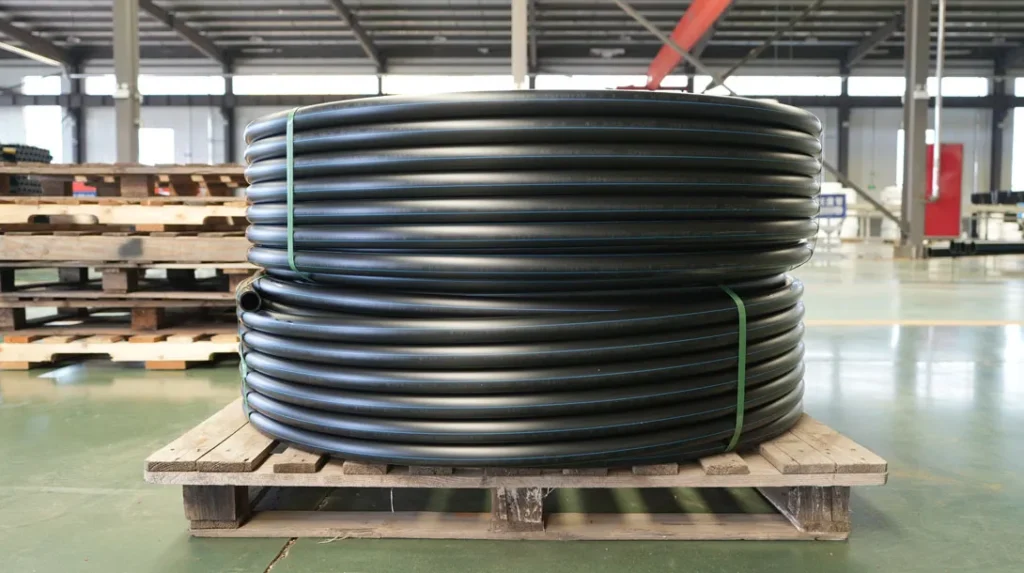
I. Core Characteristics and Advantages of PE Threading Pipe
PE (polyethylene) threading pipe is made from high-density polyethylene (HDPE) or medium-density polyethylene (MDPE), featuring:
- Strong corrosion resistance: Resistant to acids, alkalis, salts, and other chemicals, suitable for humid and corrosive environments.
- High flexibility: Can bend without breaking, facilitating construction around obstacles and reducing joint usage.
- Excellent insulation: As a protective pipe for wires and cables, it effectively isolates current to enhance electrical safety.
- Good impact resistance: Maintains toughness in low temperatures, less prone to cracking due to external forces or temperature changes.
- Long service life: Can be used for over 50 years under normal conditions, with low maintenance costs.
II. Major Application Fields and Scenarios
(1) Construction and Civil Engineering
- Indoor electrical wiring
- Used in walls, floors, or ceilings of residential buildings, office buildings, shopping malls, etc., to protect wires and cables from mechanical damage and moisture.
- Example: In home decoration, PE threading pipes can be embedded in walls to facilitate later wire replacement or new circuit addition.
- Outdoor buried projects
- Suitable for buried laying of outdoor power and communication cables, such as community power supply and streetlight line laying.
- Advantage: No extra anti-corrosion treatment is needed when buried, and it can directly pass through soil, sand, and other environments, reducing construction complexity.
- Municipal engineering
- Used as cable protection pipes in urban underground utility tunnels or for pipeline laying under roads and bridges.
(2) Communication and Network Engineering
- Communication optical cable laying
- In telecommunication networks (e.g., China Telecom, China Mobile, China Unicom), it protects optical cables from external damage, especially for long-distance buried or overhead scenarios.
- Scenario: Rural communication network construction, internal network wiring in industrial parks.
- Cable TV and broadband networks
- Laying cables for cable TV and broadband in communities or buildings to ensure stable signal transmission.
(3) Industry and Manufacturing
- Factory workshop wiring
- Protects power cables and control cables in industrial plants, adapting to high-temperature, dusty, or mechanically vibrating environments.
- E.g.: Cable management in machining workshops and automated production lines.
- Chemical and corrosive environments
- In chemical enterprises, sewage treatment plants, etc., PE threading pipes resist chemical erosion, protecting wires from damage.
(4) Agriculture and Landscape Engineering
- Farmland irrigation and power facilities
- In farmland water conservancy projects, threading pipes protect power lines for irrigation equipment or lay lighting lines in fields.
- Garden landscape and greening projects
- Protects cables for streetlights, landscape lights, and background music systems in parks and scenic areas, balancing aesthetics and safety.
(5) Special Environment Applications
- Mining and underground projects
- Underground cable threading in coal mines and metal mines, with impact resistance and flame retardancy (some modified PE materials) to meet safety standards.
- Marine and coastal engineering
- Protects cables in coastal areas or offshore platforms, resisting salt spray corrosion and humid environments.
III. Selection and Construction Points for PE Threading Pipes
- Diameter selection: Determined by the number and diameter of cables, generally requiring the inner diameter of the threading pipe to be no less than 1.5 times the outer diameter of the cables.
- Connection methods: Commonly used hot-melt connection, electro-fusion connection, or threaded connection to ensure tightness and strength.
- Construction notes: When buried, lay below the frozen soil layer or take thermal insulation measures; when bending, the radius of curvature should not be less than 10 times the pipe diameter to avoid cable abrasion.
IV. Comparative Advantages over Other Threading Pipes
| Material | PE Threading Pipe | PVC Threading Pipe | Metal Threading Pipe |
|---|---|---|---|
| Corrosion resistance | Excellent (resistant to acids, alkalis, salts) | Good (good chemical resistance) | Poor (needs anti-corrosion treatment) |
| Flexibility | High (bendable) | Medium (rigid pipes require pipe benders) | Low (needs joints) |
| Insulation | Excellent | Excellent | Poor (conductive) |
| Cost | Medium-high (high long-term cost-effectiveness) | Low | High |
| Application scenarios | Buried, corrosive environments, long-distance wiring | Indoor, dry environments | Explosion-proof, high-pressure environments |
V. Development Trends and Extended Applications
- Intelligent integration: Some PE threading pipes are embedded with sensors to monitor cable temperature and humidity, used in smart grids or smart city projects.
- Upgrading of environmentally friendly materials: Development of degradable PE materials for pipeline laying in ecologically sensitive areas.
PE threading pipes play a key role in cable protection across infrastructure, industry, and civil sectors due to their comprehensive performance advantages. With the advancement of material technology, their application scenarios will further expand in the future.编辑分享
如何在具体应用场景中选择合适规格的PE Threading Pipe?
除了文中提到的应用场景,PE Threading Pipe还可以用于哪些特殊领域?
详细介绍一下PE Threading Pipe在建筑行业中的应用案例


